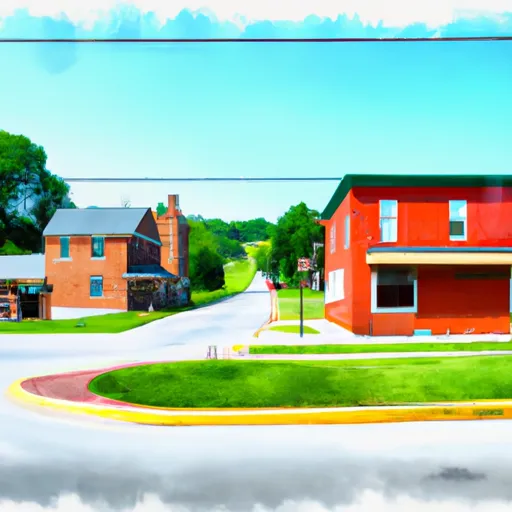-
 Snoflo Premium
Snoflo Premium
Get unlimited access to all our content
With no Ad interruptions! - Start Your Free Trial Login with existing account
Aultman
Eden Index
Climate
7.9
•
Recreation
3.4
•
Community
•
Safeguard
4.3/10

Aultman is a small borough located in Indiana County, Pennsylvania. The climate in Aultman is classified as humid continental, with warm summers and cold winters. The area receives an average of 40 inches of precipitation per year, with the majority falling during the summer months. Hydrology constituents in the area include the Conemaugh River and its tributaries, which provide opportunities for fishing and boating. Outdoor recreation opportunities in Aultman include hiking and biking on the nearby Ghost Town Trail, a 46-mile rail-trail that runs through Indiana and Cambria counties. Additionally, Yellow Creek State Park is located approximately 20 miles southeast of Aultman and offers activities such as swimming, boating, and camping.
What is the Eden Index?
The Snoflo Eden Index serves as a comprehensive rating system for regions, evaluating their desirability through a holistic assessment of climate health, outdoor recreation opportunities, and natural disaster risk, acknowledging the profound impact of these factors on livability and well-being.
Climate Health Indicator (CHI): 7.9
Aultman receives approximately
1125mm of rain per year,
with humidity levels near 83%
and air temperatures averaging around
10°C.
Aultman has a plant hardyness factor of
6, meaning
plants and agriculture in this region thrive during a short period during spring and early summer. Most
plants will die off during the colder winter months.
By considering the ideal temperature range, reliable water supplies, clean air, and stable seasonal rain or snowpacks, the Climate Health Indicator (CHI) underscores the significance of a healthy climate as the foundation for quality living.
A healthy climate is paramount for ensuring a high quality of life and livability in a region, fostering both physical well-being and environmental harmony. This can be characterized by ideal temperatures, reliable access to water supplies, clean air, and consistent seasonal rain or snowpacks.
Weather Forecast
Streamflow Conditions
Allegheny
Area Rivers
Allegheny
Snowpack Depths
Allegheny
Reservoir Storage Capacity
Allegheny
Groundwater Levels
Recreational Opportunity Index (ROI): 3.4
The Recreational Opportunity Index (ROI) recognizes the value of outdoor recreational options, such as parks, hiking trails, camping sites, and fishing spots, while acknowledging that climate plays a pivotal role in ensuring the comfort and consistency of these experiences.
Access to outdoor recreational opportunities, encompassing activities such as parks, hiking, camping, and fishing, is crucial for overall well-being, and the climate plays a pivotal role in enabling and enhancing these experiences, ensuring that individuals can engage in nature-based activities comfortably and consistently.
Camping Areas
| Campground | Campsites | Reservations | Toilets | Showers | Elevation |
|---|---|---|---|---|---|
| Outflow - Youghiogheny River Lake | 63 | 1,329 ft | |||
| Tub Run Rec Area - Youghiogheny River Lake | 101 | 1,583 ft | |||
| Mill Run - Youghiogheny River Lake | None | 1,565 ft | |||
| New Germany State Park | 48 | 2,565 ft | |||
| Swallow Falls State Park | 65 | 2,418 ft | |||
| Laurel Hill State Park | None | 2,235 ft | |||
| Savage River State Forest Dispersed | 52 | 2,403 ft | |||
| Big Run State Park | 29 | 1,492 ft | |||
| Robert W. Craig - Jennings Randolph Lake | 82 | 1,916 ft | |||
| Deep Creek Lake State Park | 112 | 2,583 ft |
Nearby Ski Areas
Catastrophe Safeguard Index (CSI):
The Catastrophe Safeguard Index (CSI) recognizes that natural disaster risk, encompassing floods, fires, hurricanes, and tornadoes, can drastically affect safety and the overall appeal of an area.
The level of natural disaster risk in a region significantly affects safety and the overall livability, with climate change amplifying these risks by potentially increasing the frequency and intensity of events like floods, fires, hurricanes, and tornadoes, thereby posing substantial challenges to community resilience and well-being.
Community Resilience Indicator (CRI):
The Community Resilience Indicator (CRI) recognizes that education, healthcare, and socioeconomics are crucial to the well-being of a region. The CRI acknowledges the profound impact of these elements on residents' overall quality of life. By evaluating educational resources, healthcare accessibility, and economic inclusivity, the index captures the essential aspects that contribute to a thriving community, fostering resident satisfaction, equity, and social cohesion.

